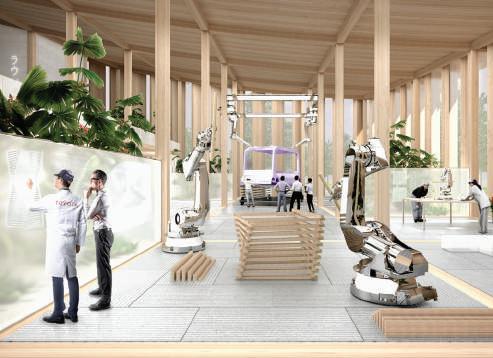
3 minute read
Kuala Lumpur, Chinatown Woven City @ Shizuoka, Japan
The Woven City features a sustainable design with buildings made mostly from carbon neutral wood. (Source: BIG - Bjarke Ingels Group)
PROJECT AT A GLANCE
Advertisement
Classification: Mixed development Location: Susono, Shizuoka, Japan
CREDIT LIST CLIENT: TOYOTA MOTOR CORPORATION + KALEIDOSCOPE CREATIVE ARCHITECT: BJARKE INGELS GROUP (BIG) T oyota Motor Corporation has unveiled plans to build a prototype ‘city of the future’ on a 175- acre site at the base of mystical Mount Fuji in Japan.
Building cities might not be the domain of car and vehicle manufacturers but Toyota has taken the bull by the horns and romped away with this project to create a first in the world for which the visionary leaders of the corporation must be duly complimented. Approx. Project Cost: Undisclosed Approx. Commencement Date: 2021 (Phase 1) Approx. Completion Date: To be announced WOVEN CITY @
SHIZUOKA, JAPAN
DEVELOPMENT COMPOSITION
Touted as a “living laboratory”, the first phase of the development on the site of a former car factory will be home to full-time residents and researchers who will be able to test and develop technologies such as autonomy, robotics, personal mobility, smart homes and artificial intelligence in a real-world environment.
Woven City is being designed by Danish architecture firm Bjarke Ingels Group (BIG) and is scheduled to break ground in 2021. The city will be built around a network of streets that cater for transportation at three different speeds. The main street of Woven City will be used by autonomous vehicles including the Toyota e-Palette, smaller streets will be for other modes of personal transport such as bicycles, scooters and Toyota’s i-walk whilst the third type of street will cater to pedestrians only. These three types of streets will then weave together into a woven grid of 3 × 3 city blocks to help accelerate the testing of autonomy.
Buildings throughout the development will be built from

Woven City will feature a network of streets that cater for transportation at three different speeds – all weave together to form an organic grid pattern to help accelerate the testing of autonomy. (Source: BIG - Bjarke Ingels Group)

Public areas include neighborhood parks and a large central park for recreation as well as a central plaza, designed to bring the community together. (Source: BIG - Bjarke Ingels Group)


carbon neutral wood and combine the traditional craft of Japanese wood joinery with new robotic product methods, as a means to preserve and evolve the old traditions through new technology.
“Each block is home to a mix of spaces for living and working. Below ground we find the entire infrastructure of the city including its hydrogen power storage and water filtration systems. A network for the autonomous delivery of goods also takes place underground connecting directly to the buildings above,” Bjarke Ingels, founder and creative director of BIG, said at a press conference detailing the concept.
“In an age when technology – social media and online retail – is replacing and eliminating our traditional physical meeting places, making us increasingly more isolated than ever, Woven City is designed to allow technology to strengthen the public realm as a meeting place and to use connectivity to power human connectivity.”
Woven City will contain research and development spaces for Toyota to develop robotic construction, 3D printing and mobility designs. There will also be housing for employees, their families, scientists and retirees. The residential buildings will contain in-house robotics and sensors connected to AI to check the residents’ health. The community will be powered by a combination of solar energy, geothermal energy and hydrogen fuel cell technology.
Toyota plans to populate Woven City with its employees and their families, retired couples, retailers, visiting scientists and industry partners. The plan is to start with about 2,000 people, adding more as the project evolves.
Toyota Motor Corporation, as a pioneer in linear production or assembly line production of cars having improvised greatly on Ford Motor Company of the United States technology before the American Great Depression, can take pride in their venture not only as a car and vehicle manufacturer but as an innovative company in holistic living which is also another feather in the cap to the Asian giant.










